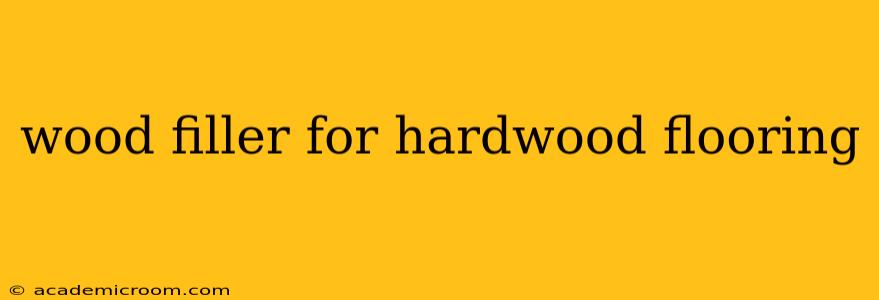Hardwood floors are a beautiful addition to any home, but even the most durable wood can suffer from dents, scratches, and gaps over time. Fortunately, wood filler provides a simple and effective solution for repairing these imperfections, restoring your floors to their former glory. This guide delves into everything you need to know about choosing and using wood filler for hardwood flooring, ensuring a seamless and professional-looking repair.
What is Wood Filler?
Wood filler is a paste-like substance used to fill holes, cracks, and gaps in wood surfaces. It's available in various formulations, each designed for different applications and types of wood. For hardwood floors, you'll want a filler that matches the color and texture of your existing flooring as closely as possible. Poorly matched filler will be very noticeable after application.
Types of Wood Filler for Hardwood Floors
Several types of wood filler are suitable for hardwood floors, each with its own advantages and disadvantages:
-
Paste Wood Filler: This is the most common type and is easy to apply and sand. It's available in a wide range of colors, making it relatively simple to find a close match to your flooring.
-
Epoxy Wood Filler: Epoxy fillers are exceptionally strong and durable, making them ideal for larger gaps or deep holes. They are often two-part systems that require mixing before application. However, they can be more challenging to work with and require careful cleanup.
-
Solvent-Based Wood Filler: This type of filler shrinks less than others, making it a suitable option for larger repairs. However, they require more precise application and sanding.
-
Wood Putty: This is a softer filler, often used for smaller imperfections and touch-ups. It's easier to apply but may not be as durable as other options.
How to Choose the Right Wood Filler Color
Choosing the correct color is crucial for a successful repair. The wrong color will make the repair stand out, defeating the purpose. Here are some tips:
- Test in an inconspicuous area: Before applying the filler to the damaged area, test it on a less visible part of the floor to ensure the color match.
- Consider the wood's grain: Look for a filler that mimics the natural grain of your hardwood.
- Mix colors: If you can't find an exact match, you might be able to mix two colors to create a closer approximation.
- Consider staining: After the filler has dried and been sanded, you may need to stain the repaired area to blend it seamlessly with the surrounding floor.
How to Apply Wood Filler to Hardwood Floors
Applying wood filler requires patience and attention to detail. Here's a step-by-step guide:
- Prepare the area: Clean the damaged area thoroughly to remove dirt, debris, and any loose wood fibers.
- Apply the filler: Use a putty knife or similar tool to apply the filler, pressing it firmly into the hole or crack. Slightly overfill the area to account for shrinkage during drying.
- Let it dry: Allow the filler to dry completely according to the manufacturer's instructions. This usually takes several hours.
- Sand the filler: Once dry, use fine-grit sandpaper to smooth the filler until it's flush with the surrounding floor.
- Clean the area: Remove any dust or debris from the sanded area.
- Finish (if needed): If necessary, apply a stain or finish to match the surrounding floor.
What kind of wood filler should I use for hardwood floors?
The best type of wood filler for hardwood floors depends on the size and depth of the damage. For small scratches and dents, a paste wood filler is often sufficient. For larger gaps or holes, a more durable option like epoxy wood filler may be necessary.
Can you use wood filler on hardwood floors?
Yes, wood filler is commonly used to repair damage on hardwood floors. However, it's crucial to choose the right type of filler and match the color as closely as possible to the existing floor.
How do I match wood filler to hardwood floors?
Matching wood filler to hardwood floors can be challenging. Test the filler in an inconspicuous area first. Consider the wood's grain and mix colors if necessary to achieve a close match. After applying, staining may be needed for a perfect blend.
What is the best wood filler for large gaps in hardwood floors?
For large gaps in hardwood floors, epoxy wood filler is often the best choice due to its strength and durability. It's less likely to shrink and crack than other types of filler.
How long does wood filler take to dry on hardwood floors?
Drying time varies depending on the type of wood filler and the environmental conditions. Always refer to the manufacturer's instructions for the specific drying time.
How do I prevent wood filler from cracking on hardwood floors?
Proper preparation is key to preventing cracking. Ensure the area is clean and the filler is applied correctly, slightly overfilling to account for shrinkage. Using a high-quality, appropriate filler is also crucial.
By following these tips and choosing the right wood filler, you can effectively repair imperfections in your hardwood floors, restoring their beauty and value. Remember that patience and attention to detail are key to achieving a professional-looking result.
